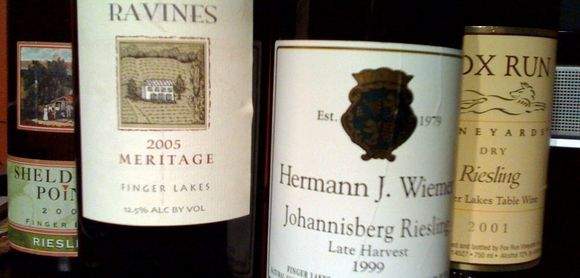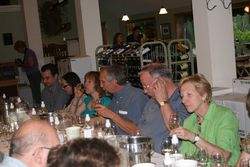
By Evan Dawson, Finger Lakes Editor
Second photo courtesy Lucas Vineyards from a recent riesling vertical tasting
See if you can answer this question: What is the greatest white wine ever made in the Finger Lakes? What is the greatest red?
For most people, that question is largely irrelevant. That's because most of us drink Finger Lakes wines within months of purchase. Bottles lay down about as much as the Statue of Liberty.
But with the growing number of quality producers focusing on making wines that can evolve and improve with bottle age, we'll soon be kicking off a new project here on the New York Cork Report. We're compiling vintage reports that will help consumers know what they might expect if they discover an older wine in the cellar, in a shop or on a restaurant wine list.
And if you talk to the winemakers themselves, and if you ask them to name a favorite vintage (or least favorite!), you find a fascinating range of responses.
Seeking the best white wine vintage
Lucas Vineyards on Cayuga Lake sold out their first-ever riesling vertical tasting in May. Winemaker Jeff Houck found that his favorite wine of the tasting was the oldest: He loved the 2001 semi-dry.
"It's encouraged me to tell customers, 'Why not lay down a couple of bottles?' If someone had laid down a case of that wine, they'd be happy people right now."
But even Houck would say 2001 was a better vintage for reds in the Finger Lakes than whites. So which is the standout vintage of the past decade?
"The rieslings of 2006 are stunning," says Peter Bell, winemaker at Fox Run Vineyards on Seneca Lake. Bell has seen two decades of vintages in the Finger Lakes, and 2006 stands out. "We endured rain during harvest, but riesling developed in this intense way. If you're setting your sights on great wine years, 2006 is one of them."
"It's hard to beat the balance of 2008," counters Johannes Reinhardt, winemaker at Anthony Road Wine Company just down the lake from Fox Run. "The complexity of 2008 was the best I've seen for riesling in the Finger Lakes. We had the acid, but we also had the flesh to fill out the wines." That fleshy quality comes largely from the botrytis of 2008, which some growers tried to avoid.
Seeking the best red wine vintage
On the red side of things, three vintages stand out to Jeff Houck: 2001, 2005 and 2007. "Those years showed very good aging potential early on," he says. "We thought they probably would age well, and we're finding out that they have."
Houck gushes about the tannin and concentration on the Lucas 2001 Cabernet Franc, but he's honest in his assessment of other vintages that haven't aged as well. "We've been surprised that '99 is not showing well. That doesn't make much sense, given the year, but it's the way it is. Everything else has lined up with our projections."
For the non-pinot reds, 2007 is likely to stand alone as the ripest, most developed vintage to date. But for a balanced vintage that favors red and white, there is close to consensus.
"It's 2005," Reinhardt says.
"You'd have to have 2005 in there," Bell says, before adding, "But of course determining the best vintage for age-worthy wine is like trying to hit a moving target. Do you want the wine delicious when young, maintaining that quality as long as possible? Do you want a big, awkward young wine that will mature? It's hard to say."
Rare treasures
In the past month alone, I've enjoyed the opportunity to drink a variety of Finger Lakes wines with some age. Here is a quick rundown, filled with surprises:
- Fox Run Vineyard 2002 Lemberger (shockingly dark, inky, but racy and fresh)
- Sheldrake Point Vineyard 2001 Cabernet Franc (Brett! In a good way! Nice round fruits)
- Anthony Road Wine Company 2005 MRS Cabernet Franc (one of the highest quality Finger Lakes reds I've had)
- Hermann J. Wiemer 2005 Dry Riesling Reserve (round, mouth-filling, long)
- Lucas 2003 Semi-Dry Riesling (plump and fruity, a little chunky)
- Hermann J. Wiemer 2001 Gewurztraminer (mature and nutty, accenting the tropical and spice notes)
Each of these wines had changed from their early-release days, and yet each was a reward for patience. Houck is already seeking better storage options as Lucas puts more emphasis on building a library. Few Finger Lakes wineries offer a library wine in the tasting room for regular customers — many explain that it's poor economics to do so — but that could change as the emphasis shifts gradually away from the "Drink NOW" model.
Wine being a subjective beast, I'll close the same way I opened: I'll go ahead and choose the greatest white and red wine ever produced from the Finger Lakes. This is a silly game, but a fun discussion nonetheless.
TasteCamp weekend led me to open a bottle of the Hermann J. Wiemer 1999 Late Harvest Riesling. Not at all a dessert wine, this is a rich but crackling wine of stellar complexity. It is almost boastfully long, maturing but still racy. Poured on the infamous TasteCamp boat, it stopped the show.
My choice for red has been, since its release, the Ravines 2005 Meritage, a blend dominated by cabernet franc. For a while it was the go-to Finger Lakes red to take to blind tastings. Now it is more rare, and I'm guarding the remainder of my allocation. Last check showed it in excellent form.
We'd love to hear your choices for your favorite vintages, along with your thoughts on the great bottlings over the years. And look for that major announcement soon from the NYCR about the vintage chart endeavor — we'll be asking not only our industry readers for input, but also consumers who have been drinking local for years.

